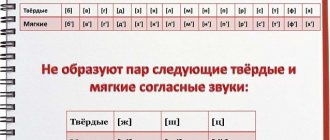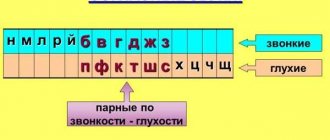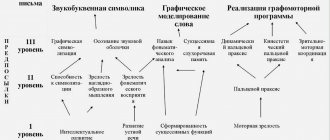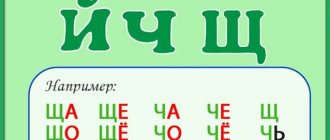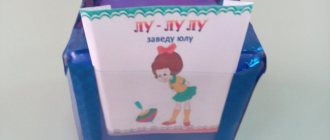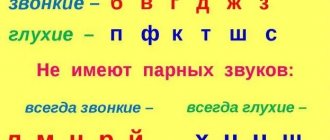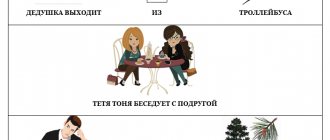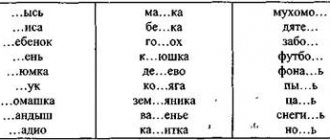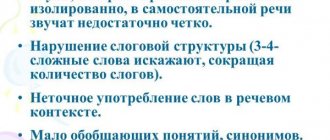How to teach children to distinguish between hard and soft consonants
The child will learn the difference if he is shown it visually or if he is allowed to feel it through experience. For example, Zaitsev's cubes with soft consonants are small in size, and with hard consonants they are large. The child makes up words and sees this difference every time.
Also, when analyzing words, you can take pictures that remind the child of something soft and something hard. For example, a pillow and a stone. Hearing a soft sound, the child shows a picture of a pillow. Pictures can be attached to cards or drawn next to letters in a notebook.
Games and exercises for children 5-6 years old to consolidate correct pronunciation and differentiate sounds
Exercises to consolidate correct pronunciation and differentiation of sounds (Senior group)
Goals
: to develop phonemic hearing, speech attention, speech breathing, to consolidate the correct pronunciation of sounds and words, to practice distinguishing between hard and soft consonants, voiced and voiceless consonants.
Game “Say me like me” (in a circle with a ball) The teacher throws the ball in a circle, names words, highlighting any hard and soft consonant sounds. The child must repeat the word in the same way and throw the ball to the teacher. All children take part in the game. If the child needs help, you need to repeat the word 2-3 times with emphasis on the sound. Exercise “Find your brother” The teacher gives the children one picture each, the name of which contains the sound “l” or “l”. Places blue and green circles on the flannelgraph. Educator. Look at your pictures. The names of objects contain the sound “l” - big brother or the sound “l” - little brother. Pick up pictures whose names contain the sound “l” (checks); now with the sound “l” Children take turns going out, calling the word highlighting these sounds and putting pictures after the corresponding circles. One child names all words with the sound “l”, the other - with the sound “l”. Game “Name the Words” The teacher asks the children to name words with the sound “r”, then with the sound “ry”. For each correct word, the child is given a toy chip. At the end of the game the winner is determined. Game “Catch a Bug” (in a circle with a ball) The teacher throws a ball to the child and pronounces the word emphasizing the sound “w”. The child, having caught the ball, repeats the word. All children must take part in the game. Educator. Now you will be bugging and buzzing loudly; Seryozha and Lena will try to catch the beetles. But if a beetle sits on a leaf (sits down, you can’t catch it. The game continues until there are 2-3 winning children left. Game “Name the Words” The teacher invites the children to name words with the sound “w” (a chip is given for each word At the end of the game, the winner is determined. Game “Whose butterfly will fly next?” Three children come up to the stand, at the teacher’s signal: “Butterflies, fly,” blow on the butterfly: “Foo-oo-oo.” Whose butterfly will fly further, that one and won. All children must take part in the game. Game “Name the sound” (in a circle with a ball) Teacher. I will name the words and highlight one sound in them: pronounce it louder or longer. And you must name only this sound. For example. , “matrrreshka”, and you should say: “ry”; “molloko” - “l”; “airplane” - “t”. All children take part in the game. Hard and soft consonant sounds are used for emphasis. If the child has difficulty with In response, the teacher himself names the sound, and the child repeats. Reading a Tongue Twister A tongue twister is read in two exhalations - two lines per exhalation. “Rain, rain, Don’t rain! Let the gray-haired Grandfather reach home.” The tongue twister is read in chorus 2 times, then only girls, then only boys and 2-3 children individually. Exercise “Name the first sound of the word ” Educator. I have different pictures, let's name them (points to the pictures, the children take turns naming them). I'll tell you a secret: a word has a first sound with which it begins. Listen to how I name the object and highlight the first sound in the word: “Drum” - “b”; “Doll” - “k”; “Guitar” - “g”. Children take turns being called to the board, naming the object, emphasizing the first sound, and then the sound in isolation. Exercise “Whoever comes up with the end will be a great guy” Not an alarm clock, but it will wake you up, Singing, people will wake up. There is a comb on the head, this is Petya. (cockerel). I washed my face early this morning. (crane) . The sun is shining very brightly, Hippopotamus has become. (hot) . Suddenly the sky became cloudy and lightning came out of the clouds. (flashed). Exercise “Name the first sound of the word” There are pictures on the flannelgraph. Children name an object, highlighting the first sound, and the sound in isolation. Game “Say the first sound of your name” (in a circle with a ball) The teacher invites the child to whom he throws the ball to say his name, emphasizing the first sound, and pronounce the same sound in isolation. All children take part in the game. Exercise “Smell the flower” The teacher invites the children to “smell” the flower - inhale through the nose, exhale through the mouth; as you exhale, without straining your voice, say: “Ah-h-h-h.” Repeat the exercise 5-6 times. Then, first quietly, then louder and louder, the children together with the teacher say: “The flower smells so good - ah! " Reading a pure phrase A pure phrase is learned and then read in two exhalations, then two lines per exhalation). Chock, chock, heel, stepped on a twig, came off, broke, chock, chock, heel. The pure saying is read in chorus 2 times, then by 4-5 children individually. Game “Find Brother” The teacher distributes pictures to the children, the names of which begin with a hard consonant sound; On the carpet or table he lays out pictures whose names begin with a pair - a soft consonant. Educator. Look what you have drawn. Think about what sound your word begins with. Your little brothers are walking in the clearing (points to the carpet). Find them. The game continues until all the children, independently or with the help of a teacher, find the desired picture. The child who picks a pair first wins. Game “Name the first sound of the word” (in a circle with a ball) The teacher throws the ball to the child and pronounces the word, highlighting the first sound, the child throws the ball to the teacher and names the first sound of the word. All children must take part in the game. Game “The song has changed” (comrade sounds “F” and “W”) Educator. Remember how a beetle buzzes (“zh-zh-zh”). This is what happened to a beetle one day: it was flying and buzzing so loudly that it lost its voice and began to sing softly. He came up with a song: “Zh-zh-zh-zh-shsh-sh-sh” (children repeat). Whose song was the beetle singing? (Wind.) When I point to the boys, they will sing the ringing song of the beetle: “Zh-zh-zh”; when I point to the girls, they will sing the beetle’s not ringing song: “Sh-sh-sh-sh.” (Children are divided into two groups - boys and girls. The exercises are repeated 2 times, then the children change roles, and the game is repeated.) When the beetle sang loudly, with a voice, its song was similar to the sound “zh”; when he sang without a voice, the song sounded like the sound “sh”. The sounds “zh” and “sh” are comrades. “F” is pronounced with a voice. And “sh” is without a voice (children repeat). I will teach you to check whether a sound is pronounced with or without a voice. Place your palm to your throat and say “Zh-zh-zh-zh” for a long time - the neck “plays” (for those who do not feel it, it is advisable to offer to put your hand to the teacher’s throat). This means that the sound “zh” is voiced and is pronounced with a voice. Now say: “Sh-sh-sh-sh” - the neck “does not play”, this sound is pronounced without a voice, it is not sonorous.
We recommend watching:
Summary of a winter walk in the senior group Summary of educational activities for the formation of a healthy lifestyle in the senior group Summary of a lesson on speech development with children of the senior group Summary of a lesson in the senior group
Similar articles:
Exercises and games for the development of speech in children 2-3 years old
Tongue twisters for practicing the sounds of the Russian language
Selective dictations on the topic: Indication of softness and hardness of consonants in writing.
Dictation 1. Task: Write down words that have soft consonants in one column, and the rest in another.
Flax, forehead, nose, but, carried, sat down, sleep, crowbar, ice, crumpled, forest, small, cancer, scream, hook, poppy, cheese, rice, climbed, people, lamp, puddle, animals, keys, straw, shore, hand.
Dictation 2.
Assignment: Listen to the poem and riddles.
Write down as many words as possible with soft consonants. Poem
The white birch tree under my window is covered with snow, like silver. And the birch tree stands in sleepy silence. And snowflakes burn in golden fire. On the fluffy branches, like a snowy border, brushes blossomed like a white fringe. And the dawn, lazily going around, sprinkles the branches with white silver. (S. Yesenin)
Puzzles
1) Whoever goes to the owner, She lets him know. (Dog) 2) Behind the fishing line, behind the fishing line, a mountain of sand is boiling. (Anthill) 3) It shines, but does not warm. (Moon) 4) It’s white in winter, and gray in summer. (Hare)
Voiced and voiceless consonants
If a vowel is pronounced with a voice, then a consonant is pronounced with a combination of voice and noise. If there is more voice, then the consonant is voiced, and if there is more noise, then it is voiceless.
The Russian language has only 21 consonants and 36 consonant sounds. They are divided by hardness and softness, by sonority and dullness, paired and unpaired.
The sonority of consonant sounds is manifested by the sound and structure of the speech apparatus. When pronouncing them, in addition to the voice, vibrations and various noise obstacles are added. These barriers distort the wave of sounds, so that not clean air, but sound, passes into the oral cavity.
For example, when pronouncing the sound [b], our lips close, and the air we exhale tries to break through the barrier. Based on this, we select voiced consonant sounds. These sounds include b, c, d, d, g, z, j, l, m, n, r - their pronunciation contains noise and voice.
Most sounds have pairs, these include: b - p (beam - stick), v - f (moisture - flask), g - k (goal - stake), d - t (house - volume), z - s (angry - layer), w - w (vein - awl).
The remaining voiced consonant sounds: th, l, m, n, r are called sonorant, which means sonorous. Sonorant sounds differ from other voiced consonant sounds in that during pronunciation the noise level is practically not involved in the formation of sound.
Summary of a lesson on teaching literacy in the senior group with developmental disabilities on the topic:
Target:
formation of the foundations for successful acquisition of the Russian language, prevention of dysgraphia and dyslexia.
Tasks:
Educational:
1. Learn to determine the place of the sound “K” in a word (at the beginning, in the middle, at the end).
2. Continue to familiarize the child with the concept: “consonant sound”, “hard consonant sound”, “soft consonant sound”.
3. Learn to determine the presence or absence of sounds
and
k'
in the word (game "Chamomile").
4. Introduce the image of the letter K.
Correctional and developmental:
1. Develop phonemic awareness.
2. Develop logical thinking (analytical and synthetic activity).
3. Develop attention and memory.
4. Develop graphomotor skills.
5. Teach to clearly pronounce the sounds K and K', differentiate them by ear and in pronunciation.
6. Enrich your vocabulary.
7. Improve phonemic hearing, fine motor skills, and tactile sensations.
Educational:
1. Arouse the emotional mood of children for the lesson.
2. Cultivate perseverance.
3. Develop proper relationships with peers and adults.
4. Cultivate a love for your native language.
5. Increase speech activity.
6. Foster a culture of verbal communication.
Wellness:
1. Promote the development of general and fine motor skills and coordination of movements in children.
2. Teach muscle relaxation (during physical exercises).
3. Monitor children’s posture while working at the table.
Materials and equipment:
The letter K (“portrait of the sound K”), mirrors, sticks, a ball, a cube, plasticine boards, peas, a paper daisy with petal pictures, the names of which contain the sounds K and K’, colored pencils, leaves with objects.
Methods:
emotional mood, gaming motivation, verbal, visual, practical.
Techniques
: joint speech activity, introduction to an imaginary situation, physical education moment.
Progress of the lesson
1. Organizational moment.
Defectologist: Today a guest from ABC came to our lesson! Let's meet her.
Defectologist: Who is this?
Children's answer: This is a letter
Defectologist: That's right, it's a letter. But she didn’t come alone... Who came with her?
Children's answer: This is sound.
2. Main part.
Defectologist: The topic of our lesson is “Sound and the letter K.”
Defectologist: What kind of assistant object do we need to choose to name the sound K?
Assignment: Let us look at the objects that are on the tray and choose a helper. (At the request of the teacher, the student chooses the object that will help name this sound).
Children's actions: Choose the right mirror.
Defectologist: Why do we need a mirror? How will it help us?
Children's answer: You can make this sound in the mirror.
Task: children take mirrors.
Defectologist: Let us pronounce the sound K.
Defectologist: To do this, the lips and teeth are in a free position and the back of the tongue is only slightly raised towards the top (palate), and the tip of the tongue is lowered behind the lower teeth. We pronounce the sound K, and then softer - K '.
Children's actions: children pronounce the sounds K and K '.
Defectologist: What is this sound?
Children's answer: Consonant, it can be hard and soft.
Defectologist: In front of you are pieces of paper on which objects are depicted. You must find the object that begins with the sound K or K ' and color it in with a colored pencil.
Children's actions: Find the desired object and color it in independently using colored pencils.
Defectologist: Now let's
play the game "Chamomile" with these sounds.
Choose petals whose names contain the sounds K and K'. When you take a petal, do not forget to pronounce the word clearly, highlighting the sounds K and K' and determine their place in the word (at the beginning, in the middle, at the end). Children's actions: Children choose petal pictures whose names contain the sounds K and K', clearly pronounce the words, highlighting the sounds K and K', and find their place in the word.
Defectologist: Now it’s time for us to rest a little. But the letter K will also rest with us. She decided to teach us how to depict it in motion.
3. Physical education minute.
Defectologist: And now we will try to depict the letter K. To do this, you need to stand in a row. Then raise your right arm slightly up and lift your right leg off the floor (stand on one leg). Change position: raise your left arm slightly up, and lift your left leg off the floor (stand on one leg).
Children's actions: children sit in their seats
Defectologist: Guys, now you need to choose again the helper objects that will help you lay out the letter K. Let's choose them.
Children's actions: children choose peas, sticks
Defectologist: Guys, tell me, why did you choose peas and sticks?
Children's answer: Using these objects you can lay out the letter K.
Defectologist: Correct. But first, look at the letter K and tell me what elements it consists of?
Children's answer: From sticks
Defectologist: Count how many sticks she has?
Assignment: Children count: one, two, three.
Children's answer: Only three sticks
Defectologist: Well done. Right. Then let us try to lay out the letter K from the selected materials (samples are attached)
Children's actions: Using peas and sticks, children lay out the letter K on plasticine boards.
4. Summary of the lesson.
Defectologist: Guys, you did a great job today in class. Tell me, please, what sound and letter did we meet today? What sound is this?
Children's answer: Sound and letter K. The sound K is a consonant, hard, and K' is soft.
Defectologist: class is over.
